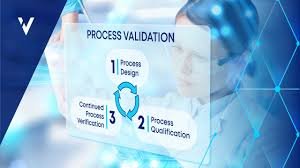What fundamental elements must be met to carry out a successful process validation?”

Fundamental Elements for Successful Process Validation
Process validation is a critical part of ensuring that pharmaceutical products are consistently manufactured to meet quality standards. It involves proving that the processes used in production are capable of consistently producing products that meet specifications and quality attributes. Here are the fundamental elements that must be met for a successful process validation:
1. Understanding of the Process
Detailed Process Knowledge
-
A thorough understanding of the process being validated is essential. This includes knowledge of each step in the process, raw material properties, equipment used, and environmental conditions. The process should be well-defined, and any critical process parameters (CPPs) that affect product quality should be clearly identified.
Critical Quality Attributes (CQAs)
-
These are the physical, chemical, biological, or microbiological properties of the drug product that need to be controlled to ensure that the final product meets the desired quality.
Example: For an injectable, CQAs could include particle size, pH, sterility, or endotoxin levels.
2. Risk Assessment
Identification of Risks
-
A risk-based approach should be used to identify potential risks that could affect the consistency or quality of the product. This is often achieved through Failure Modes and Effects Analysis (FMEA) or Hazard Analysis and Critical Control Points (HACCP) techniques.
Prioritization of Risks
-
Risk assessment helps prioritize which aspects of the process need more scrutiny during validation. Focus should be placed on the most critical areas, such as equipment settings, raw material sources, and contamination controls.
3. Well-Defined Validation Plan
Planning and Protocols
-
A Process Validation Protocol should be developed before validation begins. This plan should define the scope of validation, objectives, methods, acceptance criteria, and the responsibilities of the validation team.
Stages of Process Validation
-
Stage 1 (Process Design): Establishing the process design and identifying the key parameters and specifications.
-
Stage 2 (Process Qualification): Testing the process in a controlled setting to verify that the design is capable of consistently meeting specifications.
-
Stage 3 (Continued Process Verification): Ongoing monitoring and review of the process during routine production to ensure continued consistency.
4. Equipment Qualification
Equipment Validation
-
Equipment used in the production process must be qualified before validation can begin. This means verifying that the equipment is suitable for its intended purpose. The equipment should be properly maintained and calibrated to ensure it functions within specified limits.
Installation Qualification (IQ), Operational Qualification (OQ), and Performance Qualification (PQ)
-
IQ: Verifying that the equipment is installed correctly.
-
OQ: Ensuring the equipment operates as intended under all specified conditions.
-
PQ: Confirming that the equipment consistently performs within the required specifications during actual production.
5. Control of Raw Materials and Suppliers
Material and Supplier Qualification
-
All raw materials used in the manufacturing process must be qualified. This means ensuring they meet predefined specifications for quality, consistency, and identity.
Approved Suppliers
-
The suppliers should be reliable, and their processes must be validated as well. Using materials from unqualified or inconsistent sources could lead to variations in product quality.
6. Process Control and Monitoring
Critical Process Parameters (CPPs)
-
Identifying and controlling critical process parameters is vital. These parameters are directly related to the product’s quality and should be monitored regularly. Examples include temperature, pressure, pH, mixing speed, and drying times.
Monitoring Systems
-
Continuous monitoring should be in place to ensure that these critical parameters stay within predefined ranges. Real-time data collection is ideal for identifying any deviations from the standard process.
7. Documented Evidence and Data Integrity
Data Collection and Documentation
-
Validation should be based on solid data. Detailed records of every step in the validation process, including raw data, observations, and test results, must be documented.
Good Documentation Practices (GDP)
-
Documentation should comply with Good Documentation Practices (GDP) and be traceable. This ensures that all activities and results can be reviewed, audited, and verified during inspections or audits.
8. Performance Qualification (PQ) and Final Assessment
Testing and Verification
-
The final phase of validation (Performance Qualification) involves running the process under actual production conditions to verify that it consistently meets the product specifications. This involves testing and analysis to ensure that the product is consistently of the required quality.
Statistical Analysis
-
Statistical methods should be applied to the data to evaluate whether the process consistently produces within the desired parameters.
9. Training and Personnel Competency
Qualified Personnel
-
Only qualified and trained personnel should be involved in the validation process. This includes operators, quality control personnel, and maintenance staff. The competencies of the personnel involved in validation should be well-documented.
10. Ongoing Monitoring and Revalidation
Continual Monitoring
-
After initial validation, it’s crucial to regularly monitor the process to ensure that it continues to perform within the established specifications. This could involve in-process testing, batch records review, and routine inspections.
Revalidation
-
Revalidation might be necessary when changes to the process occur, such as equipment upgrades, new raw materials, or process adjustments.
Conclusion
Process validation ensures that pharmaceutical manufacturing processes are capable of consistently producing products that meet predefined quality standards. By adhering to these fundamental elements—thorough process knowledge, risk assessment, proper planning, equipment qualification, and ongoing monitoring—companies can significantly reduce the risk of product defects, maintain regulatory compliance, and protect patient safety.
🎓 Discover one of the best Pharmaceutical Production courses available — click below to explore the course that’s shaping future Production skills.

